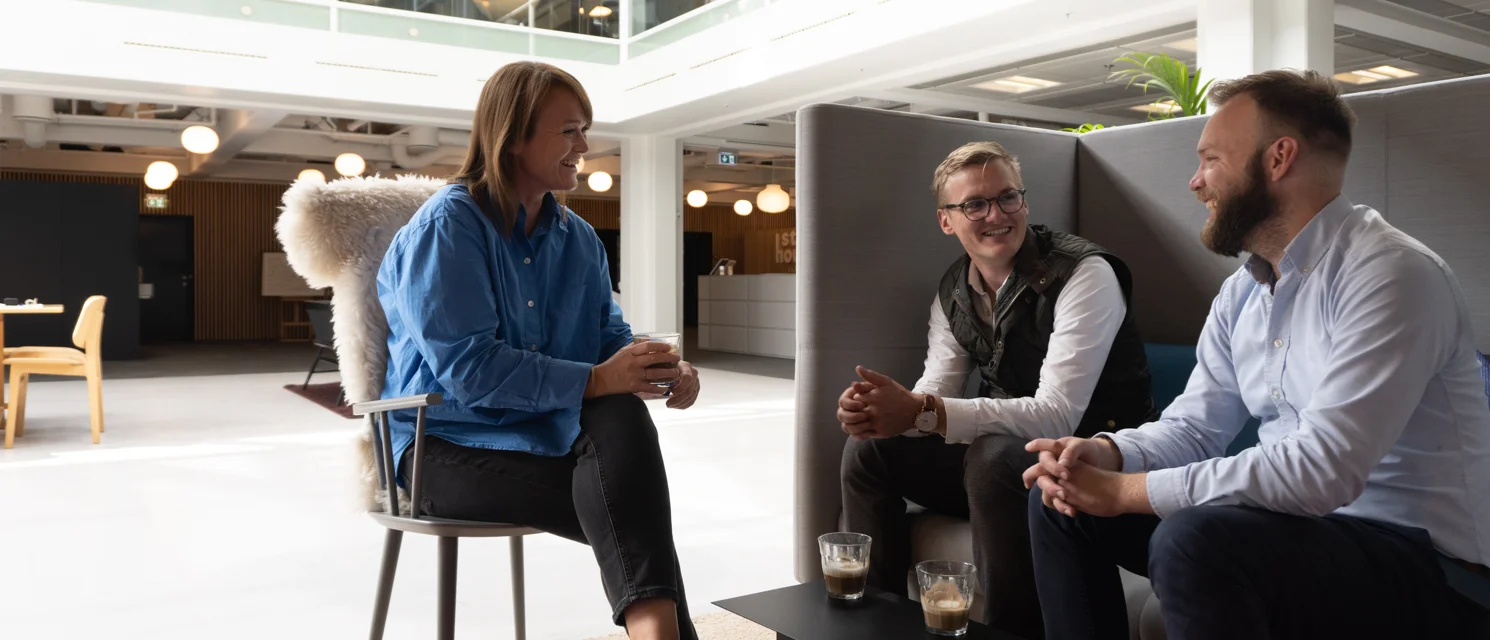What do you do when researching a product, solution or problem?
You google it, of course. “How do I get more people to convert on my website?” or “Best marketing automation tool for B2B”.
And so does your target audience, which is why it’s important to offer content that can help your potential leads and customers in their research process.
A study from FocusVision shows that the modern B2B buyer consumes an average of 13 pieces of content throughout their buyer’s journey. 13 pieces.
It shows just how important content is for the complex B2B buyer’s journey and how much you can actually influence your target group. Still, it's not an easy task.
In this article, we dive into how you can create a B2B content strategy that helps your target group through the entire buyer’s journey from the early awareness stage to the bottom-funnel decision stage.
Why a B2B content strategy is a must-have
A B2B content strategy plans how to use content (in all formats) to achieve your business goals. A good and effective content strategy helps you attract, engage and convert your target audience at all stages of the buyer’s journey - and an excellent strategy keeps your audience engaged even after they’ve become customers.
There are many advantages to having a B2B content strategy. A content strategy (and content marketing in general) is, first and foremost, a continuous and cost-effective source of website traffic and lead generation.
Your content stays online and works for you long after you publish it. Content helps you attract new leads, but it also educates your target audience and increases brand awareness.
What's not to like?
Before we get practical and delve into how you should approach your content strategy, let's go over how you create content for all stages of the buyer’s journey.
Content for all stages of the buyer’s journey
Remember that B2B visitors are at different stages of the buyer’s journey when they first interact with your company. Some will be very early in their journey, and others will be further and closer to making a purchase decision.
Potential buyers have different content needs, and you must offer content for all stages of the buyer’s journey. Only then can you be relevant and helpful, regardless of whether the potential customer is still researching or is ready to choose a supplier.
Another important reason to have content for all stages is lead nurturing. By having content for all stages, you can nurture and push leads further down your marketing funnel and get them from one stage to the next.
Let's take a closer look at the three stages of the buyer’s journey.
Awareness stage
The awareness stage is the earliest stage of the buyer’s journey. The buyer is 'pain aware', which means they are aware of their challenge or problem but don’t know that a solution exists yet.
They research their problem and try to find out more about the subject. At this stage, it’s important to focus on their challenges and guide them as well as possible, even though you might not have the solution.
Consideration stage
At this stage, the prospect has become 'solution aware', meaning they have identified their problem and know the different solutions that exist. They research and try to better understand the different options available to solve their challenge.
Decision stage
When reaching the bottom of the funnel, the buyer is 'product aware'. They know your product/service well but have yet to decide on a supplier. At this stage, they also research and compare different suppliers concerning features, prices, services, etc., to make an informed purchase decision.
As in all other marketing disciplines, you have to understand your target group: What are their challenges? What questions are they asking? How do they search for information?
When you have that insight and understanding, you can start working on your content strategy and be absolutely sure that you have relevant content for all stages.
We have collected eight steps to help you get started with your B2B content strategy:
8 steps to get started with your B2B content strategy
1. Define your goals
First, you should ask yourself: Why do I want to produce content, and what do I want to achieve with a content strategy?
You might want to drive more traffic to your website or create more brand awareness. But you might also aim to achieve something specific, like a specific number of new Marketing Qualified Leads (MQLs) per month. Whatever your goal is, it's important that you define it before you get started, as it makes it much easier to continuously analyze, track and optimize your strategy.
2. Buyer personas
Without wanting to sound repetitive, it is crucial that you have in-depth knowledge of your target group(s), also called buyer personas.
If you know your buyer personas, you will be much better prepared to communicate to their needs and produce relevant content that they actually want to read.
3. Content audit (If you already have content)
If you have already started blogging and working on your content marketing, doing a content audit of your existing content might be a good idea.
A content audit helps you gain an overview of how much content you have, what kind of content performs well and where there is room for improvement.
It might turn out that you have a lot of awareness content and need to focus on creating more bottom-funnel content for the consideration and decision stages.
4. Brainstorming
We now reach the creative part of the strategy, where you need to start brainstorming good content ideas. To get started, we have collected some best practices:
- Joint workshop
Gather your sales, service and marketing departments for a workshop where you can discuss all the questions you each get from leads, customers, prospects etc.
What do the customers often ask? And what are some questions that salespeople always answer in their sales meetings?
Write all the questions down so you can return to them later and create content pieces that answer the most relevant questions. It’s also a good idea to create a document where the salespeople note down every time they get a new question in their sales dialogues. This way, you can build a backlog of good content ideas.
- Find inspiration from top performers
Get inspired by what others write about the same topic. On BuzzSumo you can enter your topic, and the search engine will list the most popular content pieces on exactly that topic.
It can be a great help to see how others have approached the same task. Find out what the best blog posts have in common and find a way to do something similar.
- Idea generator
It is definitely not easy to come up with good ideas. That's why HubSpot has created a Blog Idea Generator to help you on your way. You can enter up to 5 words and have it spit out ideas for blog post titles.
When you've got an idea, run it through a headline analyzer that gives you feedback on the title, length, keywords, wording, etc. But note that it can only help you with English content.
5. Decide which content formats you want to create
When deciding which content formats to focus on, consider your target group and think about which content formats they prefer to interact with.
If you start producing content without having done your research, you risk wasting time on content formats that your target audience doesn't interact with at all. Specific formats have certain advantages depending on your content strategy goals.
For example, written blog posts significantly affect SEO and whether you appear in organic searches. However, with video, you can track views that you can later use to create re-targeting campaigns. Consider creating gated content to collect first-party data if you'd like to get more leads.
6. Channels - where should your content live?
The content formats you choose must be linked to your channel. Remember that just as you can create content in different formats, you can also publish your content on many different channels.
Again, it depends on where your target audience is present. If your target group prefers longer articles and e-books, you should probably consider publishing your content on LinkedIn that focuses more on information and knowledge-sharing than let's say, Facebook.
If you cater to a younger audience that prioritizes fast and engaging content, then Instagram or TikTok are the more obvious choices.
You might also have an inbound channel you can choose to post from, such as a newsletter or a knowledge bank. Remember to include your internal channels in your content strategy.
7. Conversion optimization
It’s important to include calls to action (CTAs) in all your content if you want to convert your visitors into leads.
If you have multiple types of conversion points, think about which one fits the stage of the buyer’s journey you're writing for. If it’s very early in the buyer’s journey, perhaps it shouldn’t be a CTA such as 'contact us now' but perhaps something more top-funnel such as signing up for a newsletter or downloading an e-book.
If you would like to increase your conversion rate, you might consider creating landing pages for your conversion points. Place your form on an external page that only focuses on one goal - to get your visitors to convert.
8. Content plan
To make it as easy for yourself as possible, create a content plan containing all the content that needs to be produced, including who will make it, when it will be published and on which channels it will live.
That way, you can plan and allocate your time because, let’s face it, you probably also have 117 other tasks that you need to run with. Set realistic goals and deadlines depending on how big your team is. And remember, when dealing with content, quality always beats quantity.
Topic cluster structure
It’s important to maintain a structured approach to content production, and for this, topic clusters can be a big help. Using topic clusters forces you to start from one topic to create a 'cluster' of content around that topic.
Moreover, topic clusters show Google that you know a lot about the same subject while you position yourself strongly in relation to your target group and assume an expert role.
You might have heard the term pillar page before, the central piece of content from which your entire cluster springs. It‘s supposed to be the most exhaustive source on the subject, meaning that you want it to show up in the search engine when people google your topic.
Let's use this article as an example. This article is a pillar page on the subject of B2B Content. It is the central piece of content that tells you a little bit about everything within B2B content. If you, for example, want to read more about B2B lead generation or gated content, you should read one of the more in-depth articles in the same cluster.
With topic clusters, you can easily see which content pieces you need to create to cover everything about the relevant topic. And if you succeed, you can claim your position as an expert.
A good B2B content strategy focuses on your buyer persona’s challenges and helps them through their buyer’s journey by answering their questions, enabling them to make an informed purchase decision. Once they are ready to talk, you can convert the sales-ready leads that are far along in their buyer’s journey.
Start building your content strategy today
We can help you shape your content strategy and create impactful B2B content; check out our content services for more information.


